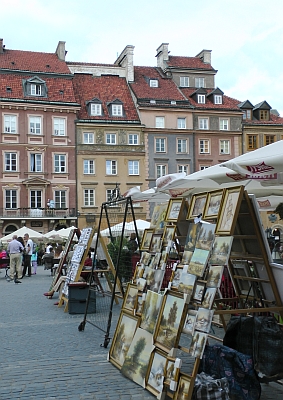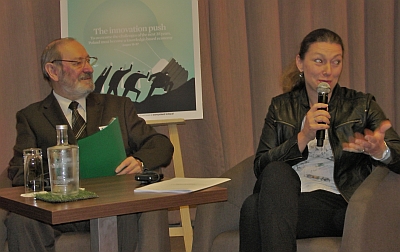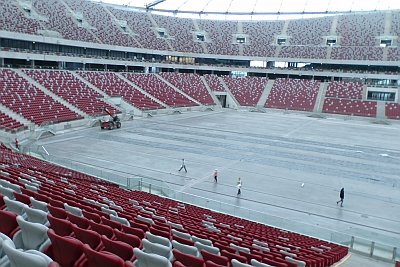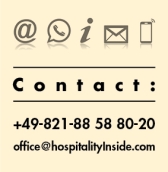"Spotlight Hotel Investment”: A country with space, potential and power
 |
|
| Warsaw's idyllic old town: a hot spot for tourists and locals. |
Warsaw (June 13, 2014). Poland – a country on the threshold to the international tourist market. Diggers and construction cranes in Warsaw signal how much is in motion. At the same time, the Poles are positive and open to change. The stable growth figures for the Polish economy show an active and industrious nation whose greatest tourist potential currently rests in its authenticity and undiscovered nature… International investors and operators haven't managed to get to grips with the hotel market yet, but the mood two weeks ago at the 1st Hotel Conference "Spotlight Hotel Investment Poland” certainly made their strong interest clear.
With around 160 participants – including renowned investors, owners, operators and consultants from Poland and other European countries (see link) – this first conference at the Golden Tulip Hotel Warsaw was an immediate success, so much so that the second "Spotlight Hotel Investment Poland” has already been scheduled: 15 June 2015, again in Warsaw.
Just how things were in today's hotel and tourism market in Poland, statistics from STR Global are able to reveal. The flagship destination Warsaw performs well in the Central and Eastern European (CEE) comparison: Its average daily rate (ADR) in 2013 stood at over EUR 70, roughly the same as in Prague, Tallinn and Bucharest. However, average occupancy of around 72% puts Warsaw together with its Polish sister city Krakow in pole position, ahead of all 18 surveyed cities in CEE.
Such results are certain to pique the interest of hotel developers, investors and operators, especially when 58% of Polish hotels still belong to no brand. In Poland itself, Krakow and Warsaw scored highest in terms of occupancy (over 70%) followed by Gdansk (approx. 64%), Worclaw (60%) and Poznan (51%). With an ADR of 300 zloty (approx.. EUR 73), Warsaw and Gdansk were some way ahead of the other Polish cities which recorded ADRs of between 50 and 120 zloty (EUR 12 to EUR 29). The figures in the first few months of 2014 were all trending upwards.
Is Warsaw already ready for a Raffles?
Theoretically then, a good basis, as Katy Miller, Business Development Manager at STR Global explained. In practice though, things are more sober, as the first talk-round of Polish tourism specialists and hoteliers revealed. The top ADR of EUR 73 only applies to 5-star hotels. And that is certainly too little. It's all the more surprising then to find out that across from the legendary Bristol Hotel (Starwood Luxury Collection) in the city centre, a Raffles Hotel is being built.
The 100 rooms (of 50 sq.m. minimum size) and suites will open in December 2016 once renovation works for EUR 65 million on the former Europejski, the oldest hotel in Warsaw, formerly part of the state-owned Orbis group, are completed. After the fall of communism, the heirs of the original owner claimed the hotel. According to media reports, they then sold two thirds of their holding to the Swiss businesswoman Vera Michalski-Hoffman, who, according to Wikipedia, is also a stakeholder in Hoffmann-La Roche, and, as publisher, has a focus on Eastern European literature.
 |
|
| Representatives from politics and research: Polish Undersecretary for Tourism, Katarzyna Sobierajska (right) and the Director of the Tourism Institute, Dr. Krzysztof Lopacinski, see Poland on the right path. |
Poland shapes its own tourism
International branded luxury hotels are geared towards international travellers and wealthy Polish guests. Accordingly, this is a long-term project. After all, the lion's share of guests in Poland (80%) comes from Poland itself. Given the steady GDP growth in recent years, the Polish are beginning to travel more. Most still prefer cheaper hotels. "That puts pressure on average rates," Sebastien Denier, Vice President Central & Eastern Europe at Louvre Hotels, said "though this segment of Polish tourism is very stable." Meanwhile, there is more movement: "We currently see more Poles looking for 4-star hotels, especially in Krakow and Warsaw." With 16 hotels and 9,100 rooms, Louvre Hotels is one of the biggest brand providers in the country.
"Yes, there’s still a lot to do," Katarzyna Sobierajska, UnderSecretary of State in the Polish Ministry of Sport and Tourism, said encouragingly to those attending the conference, "the ratio of beds to guests is still not satisfactory". The Football European Cup in Poland and Ukraine in 2012 gave the country an important push, primarily in terms of hotel investment, much of which began in 2009 and as such mitigated to some degree the effects of the global financial crisis. At the end of 2013, EU subsidies for hotels in Poland will expire, "now, we're looking to improve competitiveness," the Undersecretary underlined.
More international tourists but strategies are missing
According to statistics from the Polish Tourist Board,15.8 million foreign guests stayed in Poland last year for at least one night. Around one million more than in 2012 and 30% more than in 2009. Germany is the most important foreign source market with 5.3 million guests; the second most important market (up to now) is Ukraine with 2.1 million tourists followed by Belarus (1.5 million)
In total, the hospitality market represents only 1.1% of the economy in Poland and is as such not a very significant industry, Dr Krzysztof Lopacinski said, Director of the Institute for Tourism in Poland, dampening the euphoria.
 |
|
| The hoteliers Ireneusz Weglowski (left) and Sebastien Denier criticize Poland's tourism policy. |
Nevertheless, his statistics too were positive: The share has remained steady over recent years and higher quality hotels have benefitted from rising incomes in Poland. Weekend and short-break tourism has also increased.
Poland's hoteliers are looking to the future – and are demanding more, also from partners in the Ministry of Tourism. "Poland no longer lacks beds, but many cities lack tourist events," Ireneusz Weglowski criticised, Vice President of the largest Polish hotel chain Orbis SA (64 hotels) and President of the Chamber of Commerce of the Polish Hotel Industry (IGHP). He pointed out that across the country, average occupancy is below 50%! He also called for a national coordinator to push activities forward faster. "Everything is moving too slowly…” His Louvre colleague, Sebastien Denier, agreed fully: "We are comparing ourselves too much with Budapest and Prague instead of looking at ourselves… A general strategy for Polish cities is absent, everyone wants to do the same… Proper marketing and communication to attract international guests is also absent."
Brand hotels can push image and close gaps
The discussion also revealed that Warsaw, as capital city, was mainly lacking MICE business. A few international sales conferences and a UN Climate Change Conference (2013) are not enough by far. "We need a convention centre in Warsaw," Mateusz Czerwinski, Senior Marketing Manager of the Warsaw Convention Bureau said as the Undersecretary listened on.
Katy Miller form STR Global advised Poland to allow more international brands into the country. They would provide concrete help in closing the rate divide between weekday and weekend tourism and would also boost the image and international awareness of Poland as travel destination. According to Christie+Co Poland, Orbis, Best Western and Louvre Hotels Group are the three leading hotel groups in the country (with 64, 20 and 16 hotels); the mega chains such as Hilton, Rezidor, Starwood and IHG have only between 5 and 10 hotels in Poland at the moment. Even Marriott – the first large global brand to open doors in Poland now 20 years ago – currently counts only two hotels.
 |
|
| For the European Soccer Championship in 2012 a new stadium in Warsaw was built - a jewel but no replacement for the missing convention centre. / photos: map |
Of course, almost every one of the chains currently has projects in the pipeline and there are also some new names as well. InterCity Hotels, Leonardo, Meliá and Motel One are already looking for new locations. Motel One has recently secured its project: 190 low budget design rooms in the very centre of the quaint (rebuilt) old centre of Warsaw.
With this image – Warsaw between Raffles and Motel One – Poland also shows that it’s a country in the sights of key players; a country set to take the same path of hotel development as many other markets. Land prices in Poland are rising, as are transactions in freshly renovated hotels. "For the first time, we are now seeing hotels as a real alternative to the office, retail and housing market," Małgorzata Dybaś says, Managing Director Poland at the consultancy Hotels Asset Management and a co-organiser of the hotel conference. "Poland offers security, stability and in the near future also liquidity. Hotel finance is also easier to come by than in other countries in the region. All that will certainly raise investor appetite for Polish hotels." (Further reporting to follow.) / Maria Puetz-Willems
Continuative Links:
To print this article you have to be registered and logged in for newsletter, visitor or subscription.





